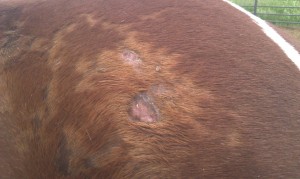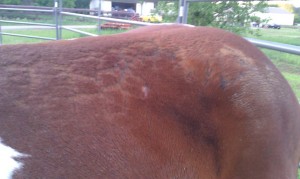“What is the best treatment for rain rot?”
Dr. Kimberly Gryl’s Answer:
Pam:
Rainrot can be a painful condition, and usually arises during the winter months due to increase of moisture and use of blankets. You really want to dry the skin & coat out, and giving a bath with Betadine can help with this. Betadine has antibacterial & antifungal properties. Wet the affected areas, apply Betadine & suds up, leave on for 10 minutes (preferably standing in sunlight), then rinse very well until all is out. You can repeat every 2 days as needed. If it’s not clearing up, or appears to be spreading, then call your veterinarian out for further evaluation.
…”and started losing hair in the saddle area”…
Equine Skin problems & Hair Loss

Equine Skin problems & Hair Loss

A couple months ago I took my 4 year old draft pony to a training school, and she developed a bump under her chin and started losing hair in the saddle area on one side. When I brought her back to where she is boarded, the owner put her in a round pen for isolation in case the bump was strangles, though she never acted sick. The next day, the hair loss started to spread behind the saddle area and she got a couple spots on her neck, so I started giving her Viodine baths and this stopped it from spreading. The bump under her chin burst the same day, and healed very quickly. The property owner is talking about moving her in with the other horses soon, once the waiting period for the potential strangles is up. However she is wary of the hair loss simply because we don’t know what it is or if the other horses will get it. Her hair has been growing back for two months now, so I don’t think that having a vet out would help much. Do you know what kind of fungus or skin infection would cause hair loss in this pattern (lines not clumps), and should it be a concern if we put her in with the herd?
Dr. Kimberly Gryl’s Answer:
Sara:
Your question is tough to answer specifically. The skin condition could be a fungal or bacterial infection, or a combination of both. It may be weather related (humid, wet/rainy climates), or something that lives in the soil and is brought out more in certain types of climate/weather change. It should be treated as something potentially infectious, therefore spreadable to other horses. This happens through direct contact (horse to horse), as well as through shared tools (blankets/tack), and you. If you pet or touch one horse, then go down the aisle touching other horses, you could be the carrier that is spreading the germs.
Regarding the lump under the chin, if it is healing up and no longer problematic it is hard to worry about it. But keep an eye out for any recurrence.
I am not familiar with Viodine, but I am guessing it is an Iodine-based shampoo or soap?The use of Betadine shampoo is common on skin conditions, as it is naturally antibacterial and anti-fungal. If your horse’s hair is growing back and there are no new lesions, then you may have it under control. To achieve a diagnosis, your veterinarian will have to culture the skin/hair, or perhaps biopsy the skin if it is not healing.
Ideally, your horse should not be turned out with other horses until she is free and clear of any visible disease and has a clean bill of health from your veterinarian.
I hope this helps, good luck.
“Every summer my sorrel quarter horse loses his hair in small patches on his face and chest…”
I’ve tried some medicated shampoos and sprays for summer fungus and ick but he rubs like crazy so I know it bothers him. Can I give him benadryl pills in his feed to ease the itching or something similar? He is 1200 lbs 18 years old.
Thanks Diana
Dr. Jack Sales’ Answer:
Hi Diana,
Benadryl is not approved for use in horses. Other antihistamines are available for horses and can be used by giving in the feed or injection. You should contact your Veterinarian about these. He/she could also possibly determine the exact cause of the dermatitis and may be able to relieve the symptoms by treating the cause.
“I was told that my horse had rain rot…”
I have a 2yr.old Paint stud. When I bought him, the people told me he had rain rot, so I have been treating it as that. It seems to be getting better but now he has a couple of spots on his neck where he has no hair. Also he has lost some hair in his mane (about 2 in.) up his mane where it is just bare. Do you have any idea what this might be?? Thank You!
Dr. Cheryl Rahal’s Answer:
Melissa,
I grew up in the Seattle area, there “Rain Rot” has many meanings. 🙂 In horses it refers to a skin infection by a bacteria that has fungal-like presentation. The bacteria is called Dermatophilus, and invades the hair follicle and causes crusts with serous oozing and hair loss. It can be killed by topical bathing with betadine shampoo. It’s usually a simple bug to kill, lives in the environment and needs moisture to live. Rarely with deep infections it needs to be treated with oral antibiotics. If you are having trouble getting ride of the infection, I suggest you have your veterinarian exam your horse, he may have an underlying immune deficiency problem, or it maybe something else entirely. A skin biopsy may need to be done.





















